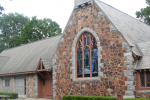June 4, 2024
Flip the Script

In part 1 of this series, I shared the back-story of how Resurrection Parish (Church of the Ascension and St. George’s Church in St. Mary’s County, MD) started putting together the sometimes disparate concepts of community + church + center. In this post, part 2 of 3, I want to share the conceptual clarity we strove to achieve as early as possible. What follows is a write-up a parishioner and I worked on in the Covid summer of 2020, and shared with our Vestry and other partners that fall. It’s essentially an exercise in ‘dilemma flipping’ – taking what some might see as a crisis or problem and flipping the script to find an opportunity or opportunities.
Present Reality
Church of the Ascension is a hub for many transformative ministries in the Lexington Park community of St. Mary’s County, MD. The church building not only houses the worship life and ministries of the Episcopal congregation, but is home to many other organizations.
The church building, built initially in 1954 and expanded in several phases in the 1960s and 70s, needs major upgrades. The list is long and expensive. Most spaces in the building are vastly underutilized, and the total campus is not set up for multiple users. Most everyone would agree that in the long run we cannot continue to ask our ever-smaller congregation to invest in a building that requires large investments in its aging infrastructure.
The present reality is not only marked by limitations and struggles, however. Ascension is in an enviable geographic position in downtown Lexington Park, planted in the most ideal place to be a center for collaborative justice in one of St. Mary’s County’s most struggling neighborhoods. The square footage and physical footprint of Ascension’s campus is not insignificant. This seems like a good time to pray about the future of this church building. Given also that Ascension has social justice and community support in its DNA, we would like to consider how we can use the building to the best benefit of the community.
For starters, technically, the Episcopal Diocese of Washington owns Ascension and all assets. We, the congregation, manage it in trust for The Episcopal Church through the diocese. While we’ve entered into relationships with other organizations, and while all of those organizations support our common life – some of whom supporting it via regular rent payments – at the end of the day the building is ours: which means the bills, upgrades and maintenance are also ours.
Re-Think Owner / Tenant Relationship
It’s time for a re-think. There’s a spectrum of possibilities, and the first step could open the door to the second. In this paper, we present two options.
On one side of the spectrum, the more conservative option, is that Church of the Ascension would encourage the formation of a more organized consortium of like-minded non-profits and faith-based communities, beginning with those organizations who already see Ascension as their home. This could begin as a monthly round-table for leaders, a regular time to check-in and build relationships. In this model, the leadership of Church of the Ascension would work closely with this consortium to achieve better usage of the church space. A mechanism would be needed for a long-term lease of tenants, and those leases might need diocesan approval. The disadvantage to this model is that the rent collected may not cover the upkeep and maintenance of the building. While it brings people together, it doesn’t move the needle on the base challenge that, at the end of the day, the Episcopal congregation is still on the hook for bills, maintenance and upgrades.
At the other end of the spectrum, the more radical re-think, is that we form a new institution – maybe a Community Development Corporation or a Community Foundation. In this model, Resurrection Parish would become a constituent member of the new organization. Other partner organizations and faith-based communities would be encouraged to join this new organization. Each organization, unto itself, would retain its own corporate status (thus, Resurrection Parish / Church of the Ascension would still exist as a Parish in the Episcopal Diocese of Washington) and each partner organization would also be a member of the new organization. In this model, the new organization would either purchase the church building and assets from the Diocese of Washington, or perhaps sign a long-term lease with the Diocese. The Tenant / Landlord concept would be flattened, and the playing field would be level. Partnerships would be key. The obvious ways to grow would be two-fold: first, to encourage all equity partners to develop the necessary institutional capacity to grow their own focus; and second, to bring on board more equity partners. The sum of these actions would ensure the long-term presence of core justice ministries in the Lexington Park community; create a safer, better-utilized building, and help ensure the long-term viability of all partner organizations.
Adaptive Re-use
This latter, more radical concept employs the principle of adaptive re-use. Adaptive re-use values the ways in which extant buildings, properties, and assets can be re-purposed for the greater good of the local community. Along these lines, guiding questions for churches that own buildings and property are about how and in what ways God is inviting us to become an active participant and meaningful partner in what the Lord is doing in our local context.
Based largely on the general principles of adaptive re-use, and The Episcopal Church’s core commitment that God has planted every church in its precise place to do good work – to “be here for good” – this proposal is about raising up the greatest common good in downtown Lexington Park by expanding the mission and use of the building currently-known-as Church of the Ascension. This proposal is not simply about decreasing costs of ownership. If done well, this would lessen the burden of the total cost to one entity (Resurrection Parish and the Episcopal Diocese of Washington) and create a safe, functional multi-use space in the downtown urban core of Lexington Park, MD which would be home to many community-minded and faith-based organizations, all of whom share a bedrock commitment to actively develop the greatest common good among our immediate neighbors. Achieving that goal, unto itself, would very significantly move the needle toward right relationships and justice.
Re-making Ascension is not a new concept. The church has expanded and modified the building several times. Even though the most recent comprehensive renovations at Church of the Ascension (2003-2004) largely focused on improving existing spaces based on the needs and uses of the Episcopal congregation at the time, in the past 15+ years God has been moving clearly to expand collaborative ministries and bring into our common life more and more partner agencies, faith-based communities, and non-profits.
Co-Working for the Kingdom of God,
A Multi-Purpose Building
Ascension’s location in downtown Lexington Park is ideal for creating a multi-purpose building. We believe we already have the foundational elements which will enable us to diversify away from being the sole owner of the building. Much like co-working spaces – a rapidly growing (and lucrative!) business phenomenon, due to the trend to move away from traditional bricks-and-mortar buildings toward more ‘network’ thinking – Ascension’s campus is already home to many non-profit groups. The problem is that it’s an inefficient, outdated, and hard-to-manage space. We could lean into our existing partnerships and let our partners lead with us. These new opportunities and create, in effect, a building which enables co-working for the Kingdom of God.
Within this proposal is the idea that the new Community Development Corporation or Community Foundation might be named the Park Community Development Corporation or Park Community Foundation – Park, as in Lexington Park. Down the road, we might re-name the whole building: the Park Community Church.
A church in Washington, DC also struggled with this landlord / tenant rubric, and leaned into the concept of adaptive re-use and the benefits of a multipurpose building. Between 2003 and 2014, Calvary Baptist Church in DC took many of these similar initiatives. Their then-pastor, the Rev’d Amy Butler, shared many of their initial learnings in an article about what they did at Calvary Baptist in DC, published in “Faith and Leadership” in 2009.[1]
Further, the inherently collaborative vision behind the nature of this new enterprise will put us, and our partner organizations in an ideal position to receive significant grant funding. We will seek potential grant funding to make the building vastly more mission-forward, purpose-driven, partner-directed and energy-efficient. Perhaps we could identify grant funding to raise up new paid positions of leadership in our community. After all, key to making this new model work would be finding a way to administer this consortium or community foundation, and make sure this new administration reduces (not adds to) the management burden on the Rector and/or his staff. Not only that, but we would add to the economic growth and development needed in the urban core of Lexington Park.
In all, this proposal envisions that we could do so much more with the assets God has given us – namely, one church building in downtown Lexington Park, MD. All of these steps would more positively impact the greatest common good in our immediate community. But what must come first, at least from the Vestry of the Parish, must be our interest to move in this larger direction, and put everything on the table.
[1] “Love God, Love your Neighbor” in Faith & Leadership, Dec. 21, 2009. https://faithandleadership.com/love-god-love-your-neighbor “A new vision of a historic tradition. A Baptist church in Washington, D.C., with a history of commitment to social justice leverages its real estate assets to help revitalize the congregation and engage community partners.”





